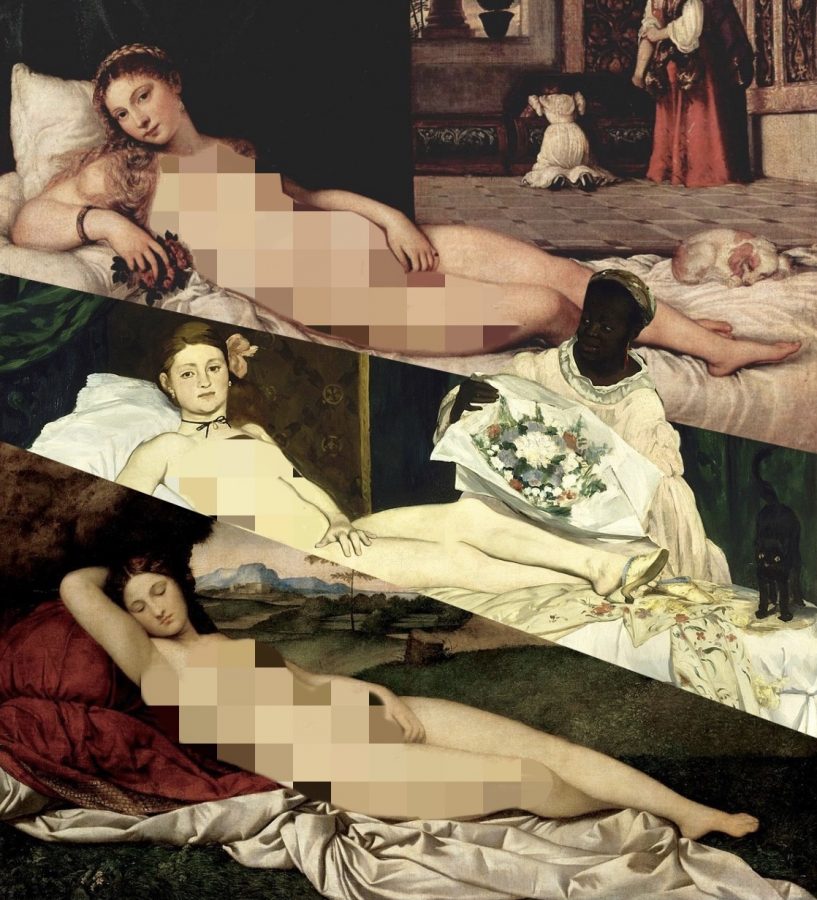Venus, Olympia: The Female Form in Modern Art
April 25, 2021
What was it about a 19th-century painting of a naked woman that changed the perception of women in the art world forever?
By now, it takes a lot to make waves in the art world. It’s challenging to create something shocking enough to change how art is made and received on a cultural level. Often, provocative pieces are met with praise from a select few and disdain or even hatred from many. Through the ages, modern and contemporary artists have met their critics time and time again, yet the movement has persisted. Revolutions in art don’t just open up the art market to new ideas, but can open all of our minds to new conversations and perspectives.
One of the many revolutions to shake the art world forever took its roots in 1508. “The Painting Sleeping Venus,” is believed to have been started by the Renaissance painter Giorgio Barbarelli da Castelfranco or more commonly known as Giorgione, in 1508, and completed in 1510 by his friend, fellow Renaissance painter Tiziano Vecellio or Titian, after Giorgione passed away the same year. The painting is of a sleeping Venus lying nude atop white and red sheets, in the grass, with rolling hills and a blue sky that wrap around the rest of the canvas. About 25 years later, Titian unveiled his “Venus of Urbino”, another painting of the goddess, fully nude, lying on her side atop red pillows and ruffled white sheets, modeled after the one he finished for his friend years before.
Three hundred twenty-nine years later, French impressionist Édouard Manet’s “Olympia” was completed and submitted to the annual Paris Salon exhibition. The Academy of the Arts ran the Salon, and judges were known for being hard to please. More than two hundred years, and five art movements later; the Salon only exhibited art that mimicked the Renaissance in composition and theme, and therefore, fell into one or more of five designated categories. These rules never changed, and year after year, thousands of artists and their paintings were rejected. The judges valued tradition and wanted nothing to do with the up-and-coming Impressionist movement. Paintings that made it past the restrictive selection process were well known and widely accepted; however, there was never a painting more infamous than Manet’s “Olympia” to grace the walls of the Salon.
“Olympia” was modeled after a high Renaissance painting, so it did conform to the standards of the Academy. However, Manet did something completely different. To understand this painting and its impact, it’s essential to know that Olympia was not an ordinary name for a woman at the time. Olympia was a commonly used pseudonym for sex workers. Despite his extensive knowledge of the renaissance and baroque periods from studying under famous baroque painters, Manet wasn’t trying to show a recreation of how Venus had been depicted in previous years by the “greats”; he used large noticeable brush strokes (typical of the impressionistic style and the exact opposite of expectations for renaissance paintings and their recreations). He also used his friend, Victorine Meurent as a model. (She later became an accomplished artist herself.) He subverted the genre in many ways, such as showing the female form nude for no profound reason, painting the woman looking straight and unabashedly at the viewer instead of down at the ground or over her shoulder, having a supposed prostitute or average woman imitate a goddess, and showcasing impressionistic painting styles on the most prestigious stage in the land. Additionally, there is a hidden meaning behind just about everything in the painting that differs from Titian’s original. There should’ve been no world in which this painting was chosen. Showcased paintings would often skyrocket an artist’s career, so being rejected was understandably a big deal. Manet had been rejected before, but by this time, Manet was only growing more popular, surprising, and well known in the community. So it’s likely that “Olympia” was chosen more for shock value and Manet’s name behind the work than the composition.
When the painting was shown, there was public outrage. People thought it was scandalous and offensive; journalists and columnists were comparing “Olympia” to animals and corpses. One of the most influential critics in Parisian society at the time said, “when our artists give us Venuses, they correct nature, they lie. Édouard Manet asked himself why lie, why not tell the truth; he introduced us to Olympia, this fille of our time, whom you meet on the sidewalks.” Little did they know, this was precisely Manet’s idea all along. However, this was not the first time Manet had caused this; his most famous painting, “Le Déjeuner sur l’herbe” or luncheon on the grass, did the same when it was released. He had unknowingly created a trend: painting the female form in a way that hadn’t been widely explored yet, and ultimately became an influential force in the rise of impressionism and the plunge into the era of modern art. While Manet was not a feminist, he opened the flood gates for many modern and contemporary female artists to later explore their femininity in art in a way that was made more acceptable.
The rise of the modern art movement and the reach of impressionism became expansive. The Modern art movement is known for being incredibly culturally diverse, and high art was no longer always expected to resemble western ideals. Early Japanese modernism embraced showing a non-idealized depiction of the female form, and as the women grew more openly rebellious in the 1920s, so did the art. NGV writer, Mariko Nagai puts it best with, “she laughed at people bound to tradition; she laughed at conventions and modesty; she laughed at being bound to men” in her article about Japanese modernism Moga: the audacity of being a modern girl. This was the perfect space for the emergence of proto-feminist artists and their rejection of the norm. High art had taken on a form different from centuries before and was no longer a space exclusive to conservative elites. Proto-feminist art was spearheaded by women like Louis Burgeois and Eva Hesse. They incorporated not only the female body in their craft but the female experience.
The official feminist art movement started in the mid-1960s. The Art history teaching resources article, Feminism, and Art describes it as “a category of art made by women consciously aligning their art practices with the politics of the Women’s Rights Movement and feminist theory.” It gave way to female artists expressing their views in new ways, like the influx of performance art, for example, Yoko Ono’s 1964 “Cut Piece”. According to a writer for Widewalls Balasz Takac in their article The Controversy behind Édouard Manet’s Olympia Masterpiece, “Édouard Manet’s “Olympia” [was] used during the 1970s as an important reference in the context of the male gaze proposed by the feminist movement.”
The feminist movement beginning in the ’60s was also a convenient time for emerging black female artists to voice their opinion of society. Takac states, “especially the Black feminists argued that Manet did not include the figure of the maid for the artistic convention, but to create an ideological binary between black and white, good and bad, clean and dirty. As a matter of fact, the black model represents all the racial stereotypes of the West, especially when juxtaposed by a person with a lighter skin,” speaking about the black woman in the back of the painting, seen handing Olympia a bouquet, possibly from a previous client. In the 90’s Lorraine O’ Grady wrote an essay titled Olympia’s Maid: Reclaiming Black Female Subjectivity, where she expressed that: “Olympia’s maid, like all other ‘peripheral Negroes’, is a robot conveniently made to disappear into the background drapery. While the confrontational gaze of Olympia is often referenced as the pinnacle of defiance toward patriarchy, the oppositional gaze of Olympia’s maid is ignored; she is part of the background with little to no attention given to the critical role of her presence.”
Artists like Martha Rosler, in her 1966-1972 collection of photos “Body Beautiful or Beauty Knows No Pain”, explored tearing apart stereotypes and media representations of beauty. According to her official website, the collection “extracts depictions of women’s bodies from popular media sources—glossy print ads and men’s magazines—and reassembles them in ways that upend the original messages… Rosler is largely concerned with the external pressures, expectations, and fantasies projected upon women. In some of the photomontages, Rosler points out the glaring commodification of women’s bodies, drawing attention to the ways that they are posed, segmented, and packaged like products for consumption; in others, she reconceives images of women meant for male consumption as gestures of defiance and expressions of liberation.”
According to the Art Story, In 1972, artists Judy Chicago and Miriam Schapiro, who were co-founders of the California Institute of the Arts’ Feminist Art Program, organized the project Womanhouse, which encompassed an entire property in Los Angeles at which various female artists contributed on-site installations. Despite the rise in recognized female artists, galleries often didn’t want to display their work. The Womanhouse project’s goal was to create a separate space instead of fighting against a system that wouldn’t allow them to be heard. The national museum on women in the arts has also recently paid tribute to Womanhouse with an exhibition of the same name.
Judy Chicago’s “Dinner Party” (1979) is most likely the largest well-known feminist art installation to come out of the movement. The Brooklyn Museum, where the installation is housed, provides the best description of the piece. The Dinner Party was a nod to 999 great females of the past (artists included) and made incredible use of imagery and symbolism to celebrate the female experience.
In 1989 the Guerilla Girls started gaining national notoriety after posting their eye-opening poster “Do women have to be naked to get into the Met Museum?” According to the official Guerilla Girls website, The Guerrilla Girls are feminist activist artists and so much more. According to Tate, which houses the poster, “[It] is one of thirty posters published in a portfolio entitled “Guerrilla Girls Talk Back.” Tate’s copy is number twelve in the edition of fifty.
According to the Guerilla Girls website, this was the poster that changed it all. The poster raised awareness about the fact that, at the time, only five percent of the artists listed in the modern art section were female, but 85% of the nudes were female. The poster is bright yellow with a black and white cut out of the woman from Jean Auguste Dominique Ingres’s “La Grande Odalisque” with a gorilla mask for a head (similar to those the Guerilla Girls wear in public). The original painting is coincidentally yet another 19th-century painting of a nude, supposed prostitute lying on a bed.
The Guerilla Girls periodically update the poster with the current statistics, which show that we have made progress. However, we still have a long way to go when it comes to accurate and equal female representation in the art world.






